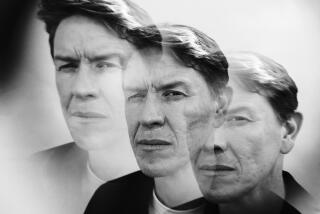Review: Paul Greengrass’ riveting ’22 July’ explores what it takes to overcome an act of pure evil
“I’m fine.”
“I’m fine.”
“I’m fine.”
The protagonists of writer-director Paul Greengrass’ ambitious, somber and significant “22 July” constantly ask each other how they’re feeling and “I’m fine” is the inevitable answer. But it’s never true. How could it be?
For on that date in 2011, Norway was witness to one of the most disturbing of modern terrorist attacks. A single far-right extremist, Anders Breivik, killed 77 people in a pair of coordinated assaults, 69 of them teenagers attending a summer leadership camp who he’d specifically targeted and methodically gunned down, screaming, “You are going to die today, Marxists!” as he did so.
“22 July” is not an easy film to watch, nor is it meant to be, and dealing with events this horrific is hardly business as usual for a dramatic feature. It’s likely only a filmmaker of Greengrass’ experience and stature could have gotten it made at all, let alone so successfully.
Starting out as a documentarian, Greengrass has made several excellent based-on-fact dramas, including “Bloody Sunday,” “United 93” and “Captain Phillips,” and he brought that same realistic sensibility to his trio of blockbuster Matt Damon-starring Jason Bourne films.
But though they take up the first part of “22 July” and are filmed with chilling precision, recreating those terrorist attacks is only one aspect of what compelled Greengrass to take on this story.
Of more significance to the filmmaker is the response, what happened after the massacre — both how one particular teenager, one of the more than 100 wounded who survived, and Norwegian society as a whole dealt with such a frontal assault on its core values.
Characteristically, Greengrass makes the unexpected choice of having perpetrator Breivik articulate what’s on his mind. When an attorney insists to the killer, “Norway isn’t on trial, you are,” Breivik snaps back, “Are you sure about that?”
How the democratic society Breivik despised, and the individuals he tried so hard to kill, maintain their humanity and find reasons to go on is what has drawn Greengrass to this material.
Working closely with master editor William Goldenberg, Greengrass has given “22 July” a relentless, remorseless quality, insisting on a matter-of-fact style that allows no escape from reality even while refusing to push anything too hard.
Though he elected to shoot this film in English, authenticity was a major concern for Greengrass. His script is based on the authoritative account of Norway’s Asne Seierstad; his cinematographer (Pal Ulvik Rokseth) is Norwegian, as is his entire cast.
Selected with the help of Norwegian casting director Ellen Michelsen, the ensemble includes only one familiar face (Anders Danielsen Lie, who appeared in Joachim Trier’s “Reprise” and “Oslo, 31 August,” in the role of Breivik), but the goal of giving the story an authentic atmosphere is definitely achieved.
“22 July” begins one day earlier, and cuts back and forth between two conflicting forces that are fated to collide on the date in question.
Breivik is discovered in a house deep in rural Norway, methodically manufacturing explosives he is going to use for the first part of his attack. Intense, focused, with a tightly trimmed chin strap beard, he is very much a man on a mission.
Meanwhile, on Utoya island outside Oslo, a group of happy teens is participating in a camp run by the youth division of Norway’s ruling Labor Party. One of the most popular boys is Viljar Hanssen (Jonas Strand Gravli), an outgoing kid from Svalbard in the country’s far north.
On the day in question, Breivik first detonates a powerful automotive bomb to devastating effect in Oslo’s government section, then drives to the ferry to Utoya and talks himself onto the island.
The killing starts immediately as terrified teens hope against hope that their hastily chosen hiding places will be good enough.
Once Breivik is captured, he pretends he has confederates but he is upfront about his ultra-nationalist, xenophobic views, his zeal to rid Norway of all immigrants and his hope that his attack will be the spark that will set off a culture war to “take back Europe.”
Breivik specifically requested the liberal Geir Lippestad (Jon Oigarden) for his attorney, and one of “22 July’s” focuses becomes what it was like for Lippestad to defend this monster, the consequences for his family and his own psychological well-being as he wrestles with giving Breivik the benefits of a system he despised.
“22 July” also spends more and more time with Viljar, who was shot five times by Breivik. We see how close he came to dying in surgery, witness his excruciating rehab and experience the great difficulties he has returning to a normal life. Finally, Viljar has to decide whether he should make a public statement at Breivik’s trial.
Though some thought is given to pleading insanity, Breivik clearly knew what he was doing: “I wanted to hit them where it would hurt the most,” he tells his attorney about the country’s liberal rulers. What he has done brings out the worst in everyone, and the question for Norway and Norwegians becomes how to deal with that.
The country’s prime minister, Jens Stoltenberg (Ola G. Furuseth) seems to speak for the film when he insists, “We must not give into this terror, we must not change. We must fight this terror with the rule of law not the barrel of a gun.” Showing how hard but necessary maintaining that attitude can be is the heart of the matter here.
------------
‘22 July’
Rating: R, for disturbing violence, graphic images, and language
Running time: 2 hours, 23 minutes
Playing: Opens Oct. 10 in limited release; also streaming on Netflix
More to Read
Only good movies
Get the Indie Focus newsletter, Mark Olsen's weekly guide to the world of cinema.
You may occasionally receive promotional content from the Los Angeles Times.











